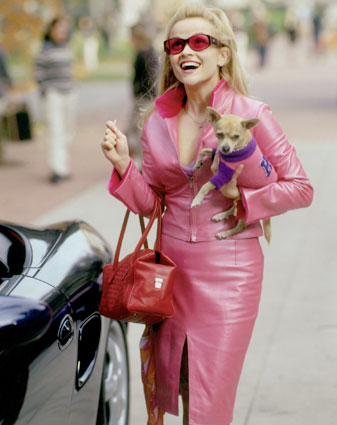

The men and women are represented in various ways in Legally Blonde. According to D.N. Rodowick, the most well known phrase in contemporary film theory is that of Laura Mulvey: "In a world ordered by sexual imbalance, pleasure in looking has been split between active/male and passive/female," (4) Sexual difference between men and women is definitely present. Rose argues, "Psychoanalysis is centrally concerned with the process through which sexual difference is established and (often precariously) maintained," (113). The film draws a clear line between men, those who have a phallus, and women, those who lack a phallus. At the beginning, it presented the active male/passive female phenomenon. In the scene where her boyfriend Warner breaks up with her, she walks down the crying while he rides along side of her, trying to get her into the car. At first she stands her ground, after he comments about her ruining her shoes, she gives in and does what he wants. Another example of showing how women are passive, Elle gives up everything she has in California to follow Warner to Law School in Boston. She desired to fulfill her fantasy of marrying him and growing old together.
| Toward the beginning of the film, Elle presented herself as an object. Her appearanceand manner set her up to be the object that men looked at and spoke of. In one of scenes when she first arrives at Harvard, she dresses in flashy, sexy clothing, goes to the football field where Warner and other guys are playing, and lounges in a chair to gain the guys' attention. She made herself a victim of scopophilia, pleasure of looking, and voyeurism, experiencing pleasure by watching a desired object. (Ott & Mack 161). As a result of her previous actions, the majority of the men in her life did not take her seriously, nor did they respect her. She is viewed through the male gaze. The male gaze is "the cinema's frequent positioning of women as objects coded for strong visual and erotic impact," (Ott & Mack 162). In order for spectators, as well as others in the film, to view her perspectives, Elle had to first respect herself, and also believe that she could be more than just a pretty face. She had to work and fight extremely hard to gain the respect of others. | 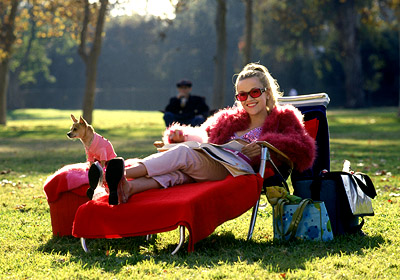 |
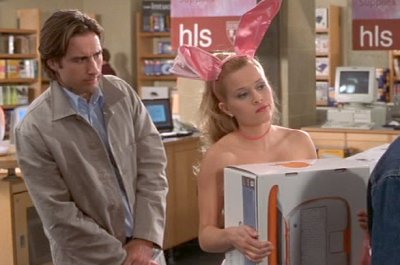 |
Towards the middle of the movie when she begins to take control over herself, she is in the process of shifting from being an object, to the subject. She is no longer passive to what men want of her, she becomes active. She finally realizes that no one would ever take her seriously if she continued to behave in the way that she was. After being humiliated at a party, she comes to this realization. She leaves, in her Playboy Bunny constume, to go buy herself a high-tech computer, and begin her new life as a serious law student. At first, the camera positions and the points of view were presenting Elle to the spectator as men would see her. By the end, it shifts from the male gaze to where the spectator could identify with her and see what she sees (Rose 121). She is now the subject of the film and challenges the stereotypes of women being passive, private, emotional, and sexual objects. She is taking on roles of what society may see as masculine. Claire Johnston would consider this "mimics of masculinity," (66). She takes control over her own life and how others percieve her. For example, her professor, Callahan, tried to make a sexual pass at her, and she denied him. One stereotype about successful women is that they "sleep their way to the top." Elle's actions challenged that stereotype. After Brooke learned what Callahan had done to Elle, she fired him. Then, she hired Elle as her new attorney. Elle shined with greatness and shocked everyone. She exposed the true murderer and won the case. | 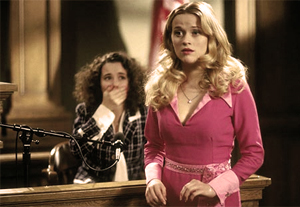 |
According to Charles Soukup, "Originating from psychoanalytic theory, media scholars have often argued that filmic, tele-visual, and print texts "objectify" women via the implied gaze of a male subject position," (22). The House Bunny works in similar ways to Legally Blonde. Shelly, like Elle, first objectifies herself and makes herself accessible to the male gaze. Her occupation as a Playboy Bunny is objectifying in itself. Many Playboy spectators fetishize, or structure "an object or person as a source of sexual pleasure," over the women presented within its products (Ott & Mack 161). In the beginning, Shelly is very passive, as are all the women who live in the Playboy Mansion. They abide by the rules of Hugh Hefner. In the beginning, Shelly passively leaves the mansion without even trying to fight for her right to stay. Everyone is able to take advantage of Shelly's kindness, and ridicule her for not being as witty as most. She is proclaimed to be oblivious like the stereotypes of most women, and unable to think logically as men are presumed to do.

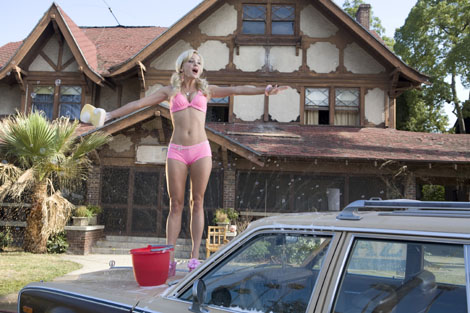 |
When she meets the Zeta girls, they are thirsty for male attention. Therefore, Shelly also changes them to also be accessible to scopophilia, voyeurism, and fetishism. She gives them makeovers, has them dress in provocative clothing, and flaunt themselves while they are washing cars. They also host a party where they present Natalie as a "sacrifice" because she is a virgin. Natalie excitedly agreed. They changed their entire image, all to gain popularity. However, they wanted attention from guys and also girls. They wanted guys to notice them and girls to join them. | 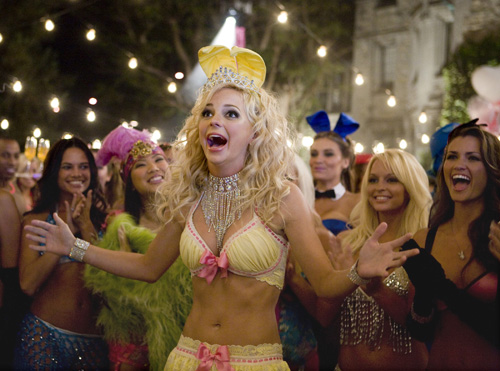 |
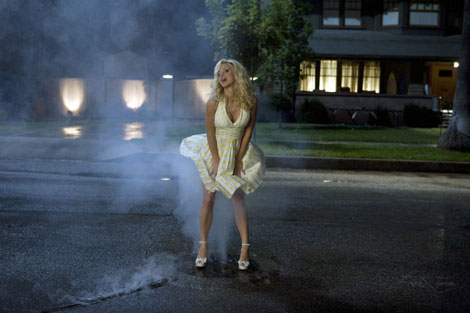
In the meantime, Shelly tries to gain the attention of a very attractive and selfless guy. She uses her same old objective actions to do so. For example, she stands over a sewer in the ground that was releasing hot steam. the steam blew her dress up as she tried to hold it down in a most sexy way. She was trying to mimic an old 'Marilyn Monroe' pose. However, objectifying herself did not work with this particular fellow. In order to impress him, she must stop being passive and pretending and be herself.
This film tells three stories: Shelly's, the Zeta girls' and theirs combined. It uses combined images of women's perspectives, along with how they are viewed to the people on the outside looking in at them. By the middle of the film, the Zeta girls realized that they had become very judgmental and plastic objects. They decide to be themselves, but also to take better care of their appearance, which they failed terribly at in the beginning. The House Bunny and Legally Blonde both have fetishistic scopophilia at their beginnings. Fetishistic scopophilia is "when the female figure is represented simply as a beautiful object of display (her objectification shows how voyeurism and this kind of fetishism can overlap)." Producers accomplish this by adjusting the framing, lighting, and camera movement (Rose 118). Though, in the end, the women appear to no longer stand objectified.